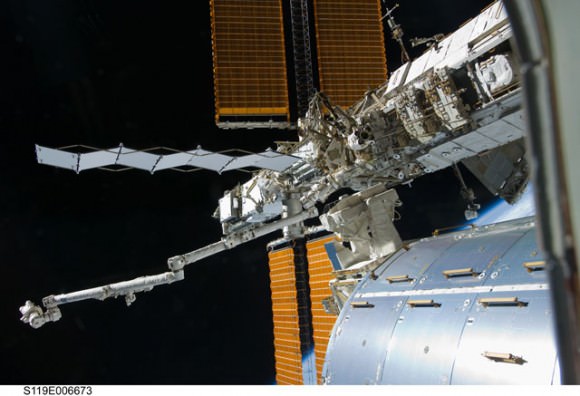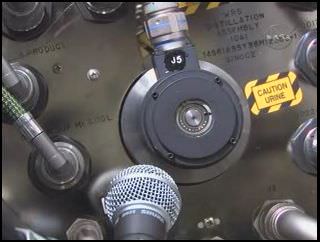[/caption]
The International Space Station’s complex water recycling system which includes a balky urine processing assembly, now appears to be working in fine fashion after the ISS/shuttle crew installed a new distillation centrifuge unit over the weekend. After initial tests and checkout, (including a sound test to record what types of vibrations the unit was creating – hence the microphone), astronauts ran a water sample through the system and no problems were reported. “We had great success with the operation of the urine processor assembly,” said Lead Flight Director for the mission, Kwatsi Alibaruho at the mission status briefing. “We were able to perform the full processing cycle of about 70 pounds of urine that has been washed through the urine processor and has been converted into clean water. So we’re very excited about that.” Having a working water/urine recycling system is critical for NASA’s plans to increase the station crew size from three to six in late May.
The water recycling system converts water collected through condensate and urine into potable water for drinking, crew hygiene and oxygen generation. The urine processor was installed during a shuttle flight last November, but the vacuum distillation assembly centrifuge malfunctioned and eventually failed.
Alibaruho said the new assembly is performing well with no anomalies so far. “In fact, we got a report from the crew that all-around performance of that unit was much better from a vibration perspective and an acoustic perspective,” he said, “so that gives us some indication that that new distillation assembly that we flew up is in good shape and quite healthy. So we’re very excited about that activity today.”
The STS-119 shuttle crew will take four samples of processed water back to Earth to be analyzed by specialists to see if the entire system can be cleared for use by the crew.

The other consumable need for increasing the crew size, as well as increasing the amount of science that can be done by a bigger crew is more electrical power. That need was met with the installation of the S6 truss and the last set of solar arrays. During the three mission EVA’s, astronauts plugged in power and data connectors to the newly installed S6 truss, prepared a radiator to cool it, opened boxes containing the new solar arrays and deployed the Beta Gimbal Assemblies containing masts that support the solar arrays.
One problem arose, however, that two spacewalks couldn’t fix. An external cargo carrier mechanism failed to deploy. This has no immediate impact on space station assembly, Alibaruho said. The jammed carrier, intended to support pallets carrying spare parts and other equipment will likely be repaired by the station crew or astronauts on an upcoming assembly flight.


Weeeeeeeeeeeeeeeeeeeee…. away!
Flush flush wiz wiz oh what a relief it is!
GO Colbert!
Should that be bulky instead of balky in the first sentence?
and pounds of urine? surely it should be litres?
Thats a crappy microphone to be testing what frequencies that urinator is making 🙂 How about something with a flatter frequency response?
“It’s all working beautifully now, the only problem we’re having is everything still tastes of piss”
@ Sci-Fi Si
You mean it converts everything into American beer? 😉
Pallets? They have forklifts in space?